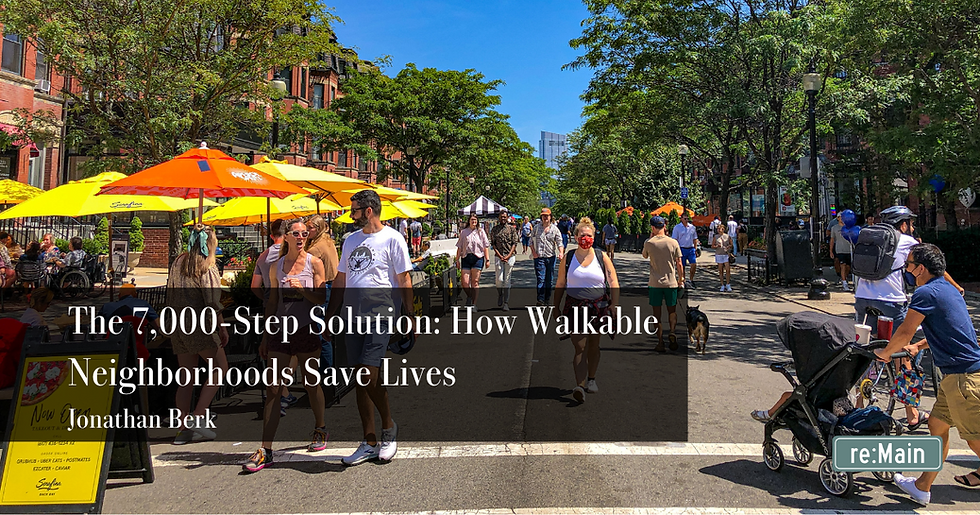The 7,000-Step Solution: How Walkable Neighborhoods Save Lives
- Jonathan Berk

- Aug 4
- 3 min read

For years, the magic number of 10,000 steps a day has been touted as the path to a healthier life. However, recent research published in The Lancet Public Health provides strong new evidence that even a modest daily movement of just 7,000 steps can significantly improve our health. This study, one of the largest and most comprehensive of its kind, examined data from 57 studies across 35 cohorts, involving hundreds of thousands of adults monitored over time. The challenge is how we, as a society, can shift from worrying about 'counting steps' to incorporating these short walks into our daily routines. By enabling more people to live in areas where they can perform more daily activities on foot, we can realize the social, environmental, financial, and health benefits of a walkable lifestyle. Here’s what they found—and why city builders, planners, and policymakers should pay close attention if they care about the broader public health picture in their community.
"Daily step volume is consistently associated with lower risks of major health outcomes. Although risk reductions occur even at lower step counts, they continue with increasing steps per day. Approximately 7000 steps per day was associated with risk reductions for all outcomes examined and might serve as a practical quantitative public health target."
Every Step Counts—Literally
The study found that walking as few as 7000 steps daily (approximately 3.5 miles or an hour of moderate walking) significantly lowered health risks. Individuals who exceeded 7000 steps per day experienced a 30% - 50% lower risk of long-term health complications when compared to those who only walked 2000 steps per day across all outcomes studied.
47% lower risk of all-cause mortality
25% lower risk of developing cardiovascular disease
37% lower risk of dying from cancer
38% lower risk of developing dementia
22% lower risk of depressive symptoms
28% lower risk of falls
The Health Benefits Plateau Around 7000 Steps
Interestingly, while walking more than 7000 steps per day continues to reduce risk for some conditions (like heart disease and dementia), the added benefit tapers off for many others. That makes 7000 steps a realistic and evidence-backed public health goal, especially for those who are less active or face barriers to intense exercise. It also reinforces a powerful idea: more isn't always necessary—just enough, consistently, makes a difference.
What This Means for Urban Design and Housing
If 7000 steps a day can significantly improve health, then making those steps easy, purposeful, and built into everyday life is critical.

That means designing neighborhoods where:
People can walk to work, school, groceries, parks, and transit
New housing is added to already walkable areas, increasing access to healthy movement
Sidewalks, crosswalks, and safe paths make those daily steps possible for everyone—including seniors and people with disabilities
Walkability is not a luxury; it is essential public health infrastructure. We must concentrate on making sure our communities encourage new housing developments in walkable areas, remove obstacles to infill housing production, and promote walkability as a solution not only to America's housing crisis but also to its public health challenges.
The Bottom Line
The Lancet study proves what we've all long known about the power of walkable cities... built environments shape our health. We don’t need elite athleticism or expensive gym memberships—just safe, inviting, walkable places where people live, work, and connect.
Designing for walkability and placing housing in walkable locations is one of the most scalable, evidence-backed ways to improve public health, reduce chronic disease, and extend life expectancy. So let’s stop counting just steps—and start counting every block of sidewalk, zoning reform, and infill housing opportunity as a step toward a healthier society.
Jonathan Berk is an experienced strategic urbanist, attorney, and policy innovator with over a decade of expertise in promoting reforms in housing, land use, and economic development through impactful public-private initiatives. He possesses deep knowledge of the structural obstacles to housing production and economic growth, such as regulatory hurdles and financing challenges, and has a proven track record of creating collaborative solutions that unlock opportunities and achieve measurable results. He is a skilled communicator, published thought leader, and a trusted advisor to policymakers, planners, and advocates working where policy, capital, and community intersect.



Comments